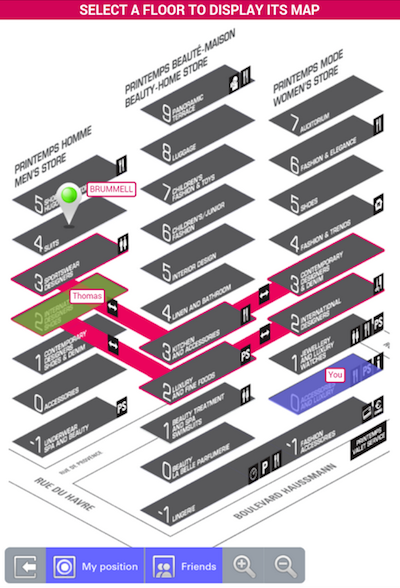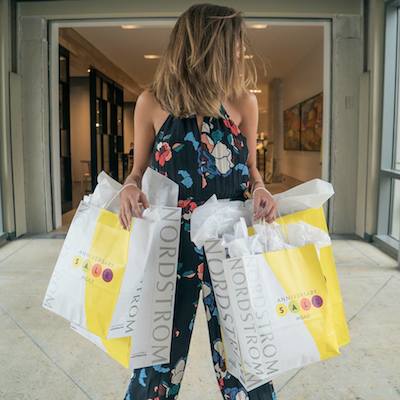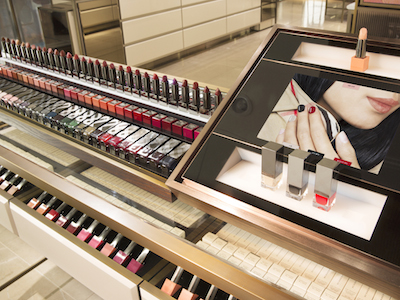 Still from Louis Vuitton mcommerce film
Still from Louis Vuitton mcommerce film
A consumer’s mobile device heavily influences her purchasing decisions, with three-quarters of shoppers using their phones to browse, research or buy when in-store, according to Boston Retail Partners.
Smartphones can help a buyer along the purchase path in key moments, but the influence of these devices could be greater if a store chooses to push or pull information or monitor a shopper’s activity as they browse. Location-based services enable a retailer to know who a consumer is on an individualized level, allowing the store to offer up a personalized shopping experience based on data and behavioral insights.
“Identifying the customer as they walk in the store is critical to personalizing the in-store experience through clienteling and guided selling – and location-based services are a necessary technology to enable the customized shopping experience consumers expect,” said Ken Morris, principal at Boston Retail Partners.
“While just a few retailers are currently tapping this technology today, 53 percent of retailers plan to have the ability to identify customers when they walk in the store via their smartphones within five years,” he said.
Finding the right fit
Within the next 5 years, 53 percent of retailers plan to implement systems that will enable them to identify consumers when they enter the store, an 883 percent increase over the 6 percent who already have these capabilities.
One means to identifying the consumer at the start of her store visit is location-based services, which can be anything from WiFi to Bluetooth-enabled beacons. These are a relatively new idea, having become commercial after the launch of Apple’s 3G iPhone and smart Android devices in the early aughts.
Boston Retail Partners says that being an early adopter of LBS technology will be a competitive advantage for those that incorporate it into their in-store experience. While the number of different solutions may seem daunting to a retailer attempting to find the right fit, launching small pilot programs to test a certain solution tend to be less costly than trying out other technologies.
 Printemps created a geolocation app to help consumers navigate its store
Global positioning system, or GPS, is the oldest location technology, relying on satellites to locate the individual. While this works better than some other options outdoors, it is not as effective indoors, relying on other technology such as WiFi to successfully locate shoppers in-store. Funded partly by the Department of Defense, GPS is basically free to use, and most consumers’ smartphones have GPS connectivity.
Tapping into GPS’ ideal outdoor use, The North Face used created a geofence, or an imaginary perimeter around its stores of up to one mile. If a consumer has opted into the brand’s location services, once they enter the predetermined radius, the brand pushes personalized marketing reminding them to visit the store, with customers attributing more shopping trips and purchases as a result of the messaging.
WiFi is fairly standard, with most stores already having wireless Internet available and a high proliferation of WiFi-enabled smart devices. To track consumers’ movements, stores do not need them to opt in, but some kind of customer interaction, such as an application download, is required to establish a platform for brands to actually talk to consumers based on WiFi.
Printemps created a geolocation app to help consumers navigate its store
Global positioning system, or GPS, is the oldest location technology, relying on satellites to locate the individual. While this works better than some other options outdoors, it is not as effective indoors, relying on other technology such as WiFi to successfully locate shoppers in-store. Funded partly by the Department of Defense, GPS is basically free to use, and most consumers’ smartphones have GPS connectivity.
Tapping into GPS’ ideal outdoor use, The North Face used created a geofence, or an imaginary perimeter around its stores of up to one mile. If a consumer has opted into the brand’s location services, once they enter the predetermined radius, the brand pushes personalized marketing reminding them to visit the store, with customers attributing more shopping trips and purchases as a result of the messaging.
WiFi is fairly standard, with most stores already having wireless Internet available and a high proliferation of WiFi-enabled smart devices. To track consumers’ movements, stores do not need them to opt in, but some kind of customer interaction, such as an application download, is required to establish a platform for brands to actually talk to consumers based on WiFi.
 Nordstrom shopper
This is a fairly popular part of in-store services, with stores such as Saks Fifth Avenue and Nordstrom offering shoppers free connectivity in exchange for the ability to learn more about them while they are online.
Radio frequency identification, or RFID, uses radio waves to track merchandise and objects. Chips embedded into items can be read with devices as they communicate via radio waves, making this a solution for logistics or keeping precise tabs on products even when they are not all visible.
However, the burden of technology implementation rests solely on the retailer, as consumers’ phones are not RFID-enabled.
One retailer that has started slowly rolling out RFID enhancements is Burberry. RFID-enabled merchandise can trigger the launch of a bespoke video about the creation of a garment or product on in-store screens and fitting rooms similarly play video content based on what the consumer brings in with them.
Also, at the brand's Beauty Box concept stores in London and Seoul, users can virtually try on a nail polish by placing a bottle onto an radio-frequency identification or RFID-enabled platform. They then choose their skin tone, and the color appears on a hand onscreen (see story).
Nordstrom shopper
This is a fairly popular part of in-store services, with stores such as Saks Fifth Avenue and Nordstrom offering shoppers free connectivity in exchange for the ability to learn more about them while they are online.
Radio frequency identification, or RFID, uses radio waves to track merchandise and objects. Chips embedded into items can be read with devices as they communicate via radio waves, making this a solution for logistics or keeping precise tabs on products even when they are not all visible.
However, the burden of technology implementation rests solely on the retailer, as consumers’ phones are not RFID-enabled.
One retailer that has started slowly rolling out RFID enhancements is Burberry. RFID-enabled merchandise can trigger the launch of a bespoke video about the creation of a garment or product on in-store screens and fitting rooms similarly play video content based on what the consumer brings in with them.
Also, at the brand's Beauty Box concept stores in London and Seoul, users can virtually try on a nail polish by placing a bottle onto an radio-frequency identification or RFID-enabled platform. They then choose their skin tone, and the color appears on a hand onscreen (see story).
 Burberry Beauty Box in Seoul
Near field communication is now accessible on most smart devices. Best used for mobile transactions or transmitting data, NFC only has a range of about 4 inches.
Using NFC beyond its typical mobile payment capacity, Argos created points throughout its stores where consumers could tap their phones to learn more about products, download the brand’s app or get special offers.
Bluetooth-enabled beacons are a fairly new technology, and perhaps the most buzzed-about LBS tactic in the past couple of years. These devices are versatile, enabling multiple types of messaging to be pushed to consumers’ phones based on their location.
In order to communicate with nearby phones, shoppers need to have their Bluetooth turned on, the store’s app downloaded and their location services on. While this may present a hurdle for retailers, it ensures that the store allows privacy for those who want it.
Burberry Beauty Box in Seoul
Near field communication is now accessible on most smart devices. Best used for mobile transactions or transmitting data, NFC only has a range of about 4 inches.
Using NFC beyond its typical mobile payment capacity, Argos created points throughout its stores where consumers could tap their phones to learn more about products, download the brand’s app or get special offers.
Bluetooth-enabled beacons are a fairly new technology, and perhaps the most buzzed-about LBS tactic in the past couple of years. These devices are versatile, enabling multiple types of messaging to be pushed to consumers’ phones based on their location.
In order to communicate with nearby phones, shoppers need to have their Bluetooth turned on, the store’s app downloaded and their location services on. While this may present a hurdle for retailers, it ensures that the store allows privacy for those who want it.
“There is a fine line between being creepy and being cool," Mr. Morris said. "Retailers need to respect the privacy of their customers and use an opt-in approach to communicating via mobile phones.
"Consumers who are brand advocates and appreciate special attention will download mobile apps, join loyalty programs, turn on location services and opt-in to a brand’s communications," he said. "For consumers who are luddites or want to remain anonymous, retailers need to refrain from pushing communications to their smartphones.
"Just because you can, doesn’t mean you should. You need to be spot on and careful of how you leverage push technology."
Goal oriented Location-based services have also found a place outside of bricks-and-mortar stores.British department store Harrods helped U.S. fashion label Ralph Lauren gain attention for its first Polo line for women with a mobile-enhanced window display.
Using mobile proximity technology, the displays let passers-by unlock exclusive and interactive content. Going beyond the traditional window display enables a brand to expand the customer experience through multiple channels (see story).
According to Boston Retail Partners, LBS are more effective as a long-term engagement strategy than as a one-time initiative. Therefore, getting the right messaging strategy for a luxury brand may take time.A Sephora executive at the Mobile Shopping Summit 2015 Oct. 14 said that while beacons open up significant opportunities for personalized in-store experiences, more time is needed to figure out the best engagement strategy and for Android’s play to develop.
Sephora, owned by luxury conglomerate LVMH, has been testing beacons in around 15 to 20 stores and plans to roll them out to more stores, the executive said during the session, Sephora Success Story: Optimizing Mobile & Instore Digital Shopping. Initial takeaways include that there is still work to be done to figure out the right messaging strategy (see story).
“Luxury retailers’ customer experience model is focused on delivering personalized, value-added services to make customer feel special,” Mr. Morris said. “Location-based services and the enhanced personalization it enables is an opportunity for the first movers to differentiate their brand from the competition.
"The key is to jump on this opportunity fast to capture new brand enthusiasts, with more of a focus on selling to my children and not my parents," he said. "The cost of piloting LBS solutions is relatively low, which enables retailers to experiment and learn in small pilots with limited risk.”

